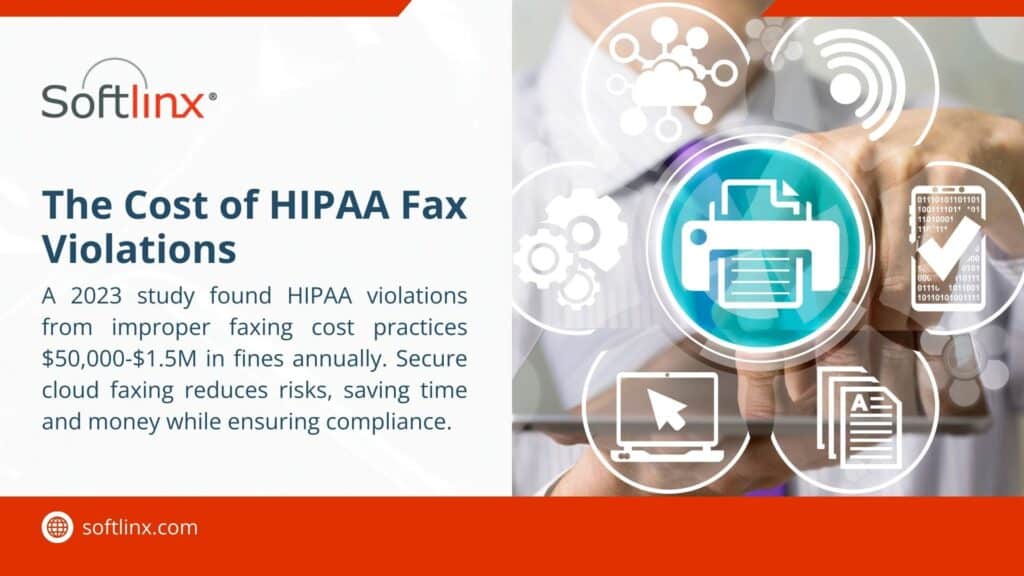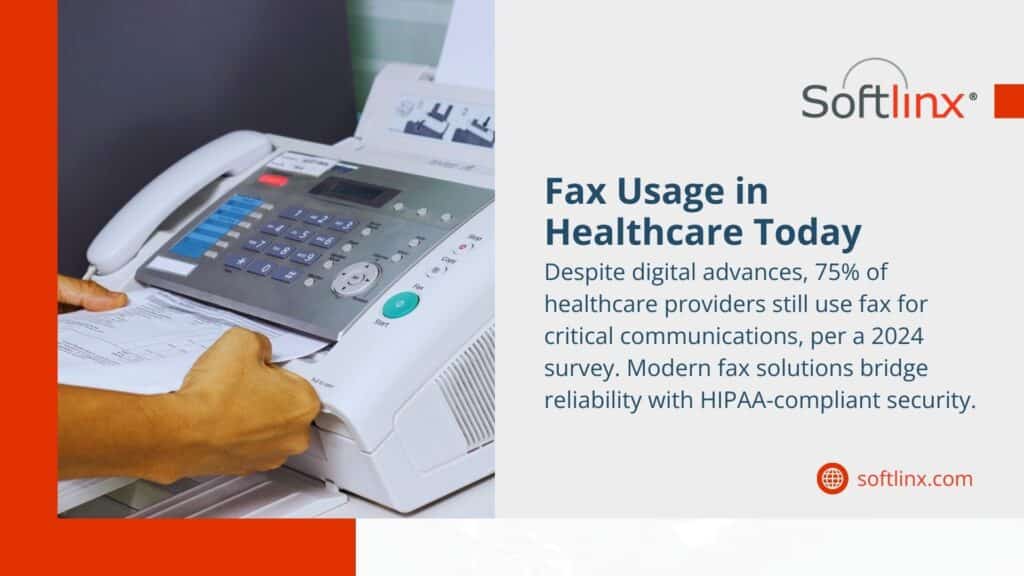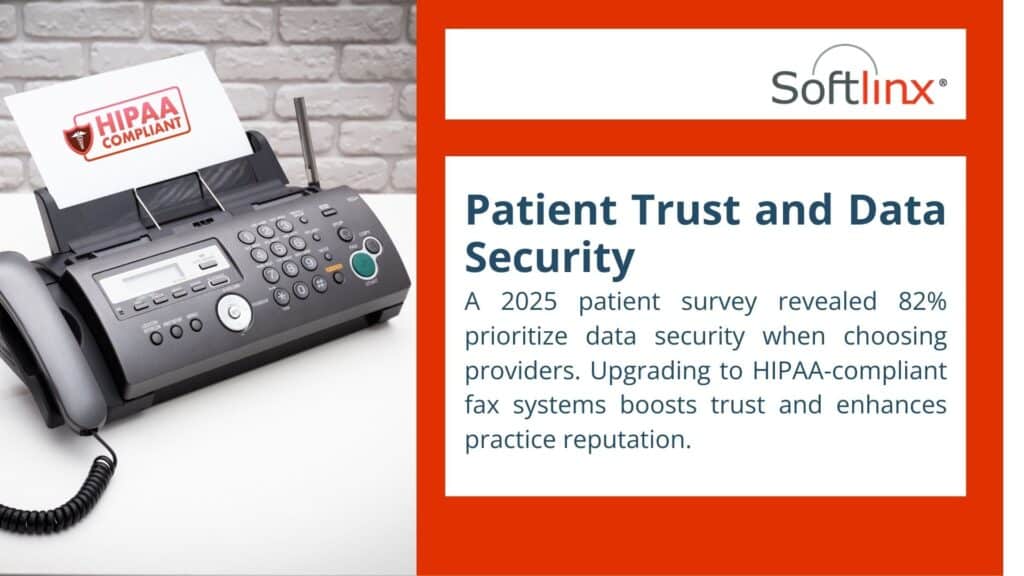Walk into most doctors’ offices today and you’ll probably spot that familiar beige box humming away in the corner – the trusty fax machine. It’s been there so long it practically blends into the furniture. But is fax HIPAA compliant?
The answer might surprise you. It’s not really about the fax machine itself. HIPAA doesn’t have a hit list of banned technologies. What matters is how you’re protecting patient information, whether that’s through smoke signals or the latest encrypted messaging app.
That old Xerox machine from 2003 is probably not cutting it anymore. But there are ways to fax patient information safely and legally. You just need to know what you’re doing.
What HIPAA Actually Cares About
HIPAA has three main things on its mind when it comes to patient data: keeping the wrong people out, tracking who gets in, and making sure information doesn’t get lost or stolen along the way.
Traditional fax machines weren’t built with any of this in mind. They’re basically just photocopiers that learned how to use the phone. When you send a fax the old-fashioned way, that patient information travels over regular phone lines with zero protection. Anyone with the right equipment could theoretically grab it.
Plus, there’s the whole paper trail problem. Or rather, the lack of one. How do you prove to a HIPAA auditor that only authorized people handled Mrs. Johnson’s lab results when your only tracking system is a handwritten log that half the staff forgets to use?
The storage situation gets messy too. Faxes pile up next to machines, sit in “urgent” stacks for days, or disappear into filing cabinets never to be seen again. None of this screams “secure handling of protected health information.”

Where Things Usually Go Wrong
Most HIPAA violations involving fax happen because of simple human errors, not sophisticated cyber attacks. Someone dials the wrong number and sends patient records to a random business across town.
The fax machine runs out of toner and incoming lab results sit in electronic limbo for hours. A stack of received faxes blows off the reception desk during a busy afternoon.
These are just the inevitable result of using 1990s technology to handle 2025 compliance requirements. The tools don’t match the job anymore.
Take the typical scenario where urgent test results come in after hours. With a traditional fax setup, those results sit unattended until someone checks the machine the next morning. If they’re abnormal values that need immediate attention, that delay could be dangerous. And good luck proving to regulators that you handled time-sensitive patient information appropriately.
Then there’s the verification problem. Most fax machines give you a transmission report showing the call went through, but that doesn’t mean the right person got it. Maybe the receiving machine was out of paper. Maybe it went to an old number that’s now disconnected. Maybe it printed successfully but ended up in the wrong hands.
Modern Approaches
Cloud fax services have basically rebuilt faxing from the ground up with security in mind. Instead of phone lines, they use encrypted internet connections. Instead of paper piles, everything stays digital with proper access controls.
The difference is night and day. When someone sends a fax through a modern system, the document gets encrypted before it leaves their computer. It stays encrypted while traveling to its destination. The recipient gets confirmed delivery, not just a “transmission successful” message.
Access controls mean only authorized staff can view specific documents. Everything gets logged automatically – who sent what, when they sent it, who opened it, how long they looked at it. If a compliance officer asks for records, you can pull detailed reports instead of frantically searching through filing cabinets.
Integration makes the biggest difference in daily workflow. Staff can send faxes directly from the patient management system without printing anything. Received documents flow automatically into the right patient files. No more walking back and forth to check if anything came in.
Most practices are shocked by how much time they save. One clinic estimated their staff spent 2-3 hours daily just managing fax-related tasks. After switching to a digital system, that dropped to maybe 20 minutes.
| Old School Fax Problems | Modern Solutions |
| Paper jams at the worst times | No physical hardware to break |
| Running out of supplies | Digital everything |
| Can’t find received documents | Automatic filing and search |
| No idea if faxes actually arrived | Detailed delivery confirmations |
| Anyone can read what’s sitting there | Role-based access controls |
Getting Your Practice Set Up Right
The transition doesn’t have to be painful. Most web portal solutions are designed to feel familiar to staff who are used to traditional fax workflows. The learning curve is usually pretty gentle.
Training tends to be the easy part. The harder challenge is changing ingrained habits. Staff who’ve been walking to the fax machine for years need reminders to use the new digital process. But once people get comfortable with the convenience, they rarely want to go back.
Document management becomes much simpler with proper systems in place. Important communications like patient safety reports can be tracked and followed up on systematically instead of hoping nothing falls through the cracks.
Setting up proper policies matters just as much as the technology. Staff need clear guidance on what types of information can be faxed, how to verify recipient details, and what to do when something goes wrong. Regular refresher training helps reinforce good habits.

The Compliance
HIPAA fines are real consequences that can seriously damage a practice. Penalties start in the thousands but can climb into millions depending on how widespread and careless the violations were.
The investigation process alone costs time and money that most practices can’t afford to waste. Staff have to drop everything to respond to regulatory requests. Lawyers get involved. Patients start asking uncomfortable questions about whether their information is safe.
Business Associate Agreements add another layer of complexity. Any third-party service that handles patient information needs to sign one of these contracts acknowledging their HIPAA responsibilities.
Traditional phone companies usually won’t do this because they’re just providing basic transmission services. Cloud fax providers understand healthcare requirements and structure their agreements accordingly.
Making Smart Choices
Cost considerations go beyond the monthly service fees. Traditional fax seems cheap until you factor in paper, toner, maintenance calls, and staff time. Hidden costs add up quickly when you’re constantly dealing with jammed machines and misfiled documents.
Reliability becomes crucial when you’re handling time-sensitive patient information. Modern cloud services typically offer better uptime than aging fax machines that break down at inconvenient moments. Plus, digital systems can route documents through backup channels if primary connections fail.
Integration capabilities vary widely between providers. Some offer basic fax-to-email services while others connect deeply with EHR systems and practice management software. The level of integration you need depends on your workflow and how much manual handling you want to eliminate.
Support quality makes a huge difference during the transition period and beyond. Healthcare providers need vendors who understand their unique challenges and can provide help when urgent situations arise.
Looking at the Bigger Picture
Healthcare communication is evolving rapidly. Fax might seem old-fashioned, but it’s still widely used because it works reliably across different systems and organizations. The key is making sure your fax setup meets current security standards.
Patients are becoming more aware of data privacy issues and asking questions about how their information is protected. Practices that can demonstrate robust security measures build trust and differentiate themselves from competitors who are still using outdated systems.
Regulatory requirements will likely become stricter over time, not more lenient. Organizations that address compliance proactively position themselves better for future changes than those who wait until problems force their hand.

Time to Take Action
Most healthcare providers know their current fax setup isn’t ideal, but they keep putting off changes because other priorities seem more urgent. The problem is that HIPAA violations don’t wait for convenient timing.
Modern fax solutions eliminate most compliance headaches while improving day-to-day operations. The technology has matured to the point where implementations are usually straightforward and staff adoption is quick.
The question isn’t whether you should upgrade your fax capabilities – it’s how long you can afford to wait. Every day of delay means continued exposure to compliance risks and missed opportunities to improve efficiency.SoftLinx has helped hundreds of healthcare practices transition to secure, compliant communication solutions that integrate seamlessly with existing workflows. Your patients deserve better protection, and your staff deserves better tools. Let’s make it happen.
